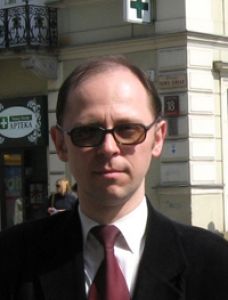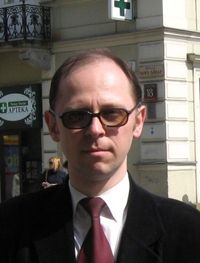Cieślak Artur
-
composer, musicologist, performer
Artur Cieślak at first worked mainly as a performing musician. He toured in Poland and other European countries (Germany, Italy, Austria, Ukraine). He made many recordings for the radio and television. He received the 1st honorary diploma at the Maria Canals International Piano Competition in Barcelona (1991) and the 4th prize of the 6th International Chopin Piano Competition in Palma de Mallorca (1992). He received a scholarship of the Chopin Society in Warsaw (1988), Polish Ministry of Culture and Art (1990) and an award from the Primus Inter Pares Foundation (1992).
In the mid-1990s he shifted his focus to composition. In 2000 his Sonata for clarinet and piano (2000) won the 1st prize at the National Composition Competition marking 80 years of the Academy of Music in Poznań. In 2003 he debuted on the international stage: his Reminiscencja (Reminiscence) for saxophone and piano (2002) and Sonata for saxophone and piano (2003) were presented during the 13th World Saxophone Congress in Minneapolis (USA). In 2009 Reminiscencja (Reminiscence) for saxophone and piano (2002) and Niedopowiedzenia (Allusions) for cello and piano (2006) were qualified to the final of the International Music Prize for Excellence in Composition in Thessaloniki, and the composer received the Certificate of Achievement in Music Composition.
His works have been performed at Musica Polonica Nova in Wrocław, Poznań Music Spring, International Festival "From Chopin to Górecki – Sources and Inspirations" in Warsaw, Silesian Days of Contemporary Music in Katowice, International Saxophone Festival in Szczecin, Laboratory of Contemporary Music in Warsaw and Białystok, Warsaw Music Encounters, International Piano Festival of the Royal City of Kraków, Spring Guitar Concerts in Szczecin, West Pomeranian Clarinet Festival, "Music Seasons" concerts held by the Warsaw section of the Polish Composers’ Union, University Concerts in Szczecin, and concerts organized in Poland, Germany, Belgium, Greece, and the USA.
Artur Cieślak has been a member of the Association of Polish Artists Musicians (SPAM) since 1992, Polish Composers’ Union since 2004, Association of Authors and Composers ZAIKS since 2007, Laboratory of Contemporary Music Association since 2008, and Polish Society for Contemporary Music since 2010.
Creation
A musical work is, in my view, a process, a cause-and-effect sequence. Thus I continue to apply the typicallly European approach towards this topic, one that is characteristic for most composers of this cultural circle. Concepts developed by cultures of the East do not have a decisive influence on my work, yet I do not reject them. In some compositions I make attempts to "suspend time".
I often get involved in an artistic dialogue with the past. I believe that no work is an isolated or singular phenomenon. The artist always participates in an incessant discussion that started when man created his first work of art.
In my pieces I strive to communicate emotions. I feel much stronger affinity with all artistic movements that give precedence to art's impact on the senses. At the same time I place strong emphasis on the logic of a piece's construction. Nevertheless, constructivism as an ultimate goal is a foreign idea to me to the point of causing physical repulsion. Although I do precede most of my composing efforts with analysis and reflection, the final verification comes from my ear, intuition and all the other unconscious processes.
While shaping the sound layer, I try to develop my own system, one that is as logical – and flexible at the same time – as possible. The system in not comprehensive at this point yet, however some procedures have started to govern my actions and proved useful in the concert practice. At the first stage of working on the sound structure of a piece I sometimes apply a technique derived from minimal music: repetitiveness, phase shifting and additive process. I use them to develop a pre-matter for the piece. I add dynamism to this static structure with the use of rhythmics, agogics, dynamics and articulation, while an important role is played by observations concerning the sound effects typical for limited aleatorism of Witold Lutosławski. Finally, the material is evaluated from the point of view of purely aesthetic standards, and in consequence, is accepted, rejected or corrected based on intuition only, without resorting to the procedures applied before. This stage is usually the most satisfying to me. I used the above method to write e.g. my Clarinet Concerto and Concerto for 2 saxophones and orchestra.
As for the form of the compositions, I like to draw on past ideas, but tend to avoid direct associations with any musical style. If I use a musical cliche or quotation, it is only in a very clear quotation mark. So far I have been interested in concertante, synthetic and open forms. In case of the first one I investigate the possibilities of transforming its main characteristics, i.e.: competitiveness, cooperation and virtuosity. I try to process these elements not only in concertante pieces, but also in solo music. For example, virtuosity was an impulse to examine the form of etude. In turn Liszt's concept of synthetic form, the idea of an open form developed by Boulez, Cage and Stockhausen, and its variants present in the work of Serocki and Lutosławski, provided me with interesting conclusions on the diversification and integration of the material in works composed of one movement. Such reflections contributed to the series of Collages for saxophone, guitar and cello. These works are made up of a series of musical thoughts, which, although unchanged, are arranged each time in different order; they also differ in number. The intention was for each version to showcase a different category of expression and achieve completely different character. The work exists in few very different, but precisely structured and well-defined versions.
Finally, let me discuss indirect inspirations. Thanks to spectralists I realised the potential of modifying the time perspective of the music material. Thanks to postmodernists I understood the power of expression that an adequately applied and processed quotation might have. Weber's aphoristic style made me see how much meaning can be put into one sound and silence. Some movements were operated by negation. Serialism convinced me that it is necessary to hierarchise the sound material. The avant-garde of the 1950s and 60s proved that it is not novelty but individualism and independence that make an artwork valuable. Realising this fact, however obvious, was perhaps the most powerful inspiration for me. It is now the main motivation for my work.
Compositions
Capricornus for piano solo (1991-1999)
Music for the End of the Century for two pianos (1991-1999)
Etudes for piano solo (1996-1999)
Musica notturna I for piano and orchestra (1996-2006)
Choral Prelude for piano solo (1999)
Sonata for clarinet and piano (2000, 2006)
Ricercar for two trumpets, French horn, trombone and tuba (2001, 2006)
Reminiscence for saxophone and piano (2002)
Sonata for saxophone and piano (2003, 2006)
Concerto for clarinet and orchestra (2003-2007)
Cadenza for cello solo (2004)
Collage I for saxophone, guitar and cello (2004, 2005)
Concerto for two saxophones and orchestra (2004, 2012)
Collage II, III and IV for saxophone, guitar and cello (2005)
Musica notturna II for piano, percussion, saxophone octet and chamber orchestra (2005, 2006)
String Quartet (2006)
Allusions for cello and piano (2006, 2007)
Vocalise for tape (2007)
Cantata in tempus quadragesimae for tenor solo, two mixed choirs, percussion and strings (2007)
Shades of Silence for viola and piano (2007, 2009)
Three songs to poems by Tadeusz Różewicz for voice and piano (2008)
Monolog for alto saxophone (2008)
Dies irae for mixed choir a cappella (2008, 2011)
Grotesque for piano for the left hand (2008-2009)
Epigram for piano for the left hand (2009)
Piano Concerto for the left hand and symphony orchestra (2009)
Trio for piano, violin and cello (2009-2014)
Monolog version for clarinet (2012)
Expressions for symphony orchestra (2012)
Collage I version for clarinet, marimba, vibraphone and cello (2013)
Collage II, III and IV version for clarinet, marimba, vibraphone and cello (2013)
Piano Sonata No. 1 "Post – Neo" for the left hand (2013-2014)
Cellofonia for cello (2014)
Psalm LVII for mezzo-soprano and percussion (2014)
Music for wind instruments and percussion (2014)
De profundis for 8-part mixed choir a cappella (2014)
Publications
articles & papers
Intelektualne, emocjonalne i duchowe aspekty twórczego wykonawstwa fortepianowego, Zeszyty Naukowe Akademii Muzycznej w Warszawie 1993 nr 26
Stefan Rieger, Glenn Gould i sztuka fugi, „Ruch Muzyczny” 1998 nr 8, s. 38 - 40
Wokół Festiwalu Młodych Pianistów w Siedlcach, „Ruch Muzyczny” 1998 nr 16, s. 22 - 24
Akt twórczy w wykonawstwie fortepianowym, „Ruch Muzyczny” 1998 nr 25, s. 8 - 10
Przed Europejskim Konkursem Chopinowskim, „Ruch Muzyczny” 1999 nr 5, s. 21
Szczecińska orkiestra Academia, „Ruch Muzyczny” 1999 nr 12, s. 8 - 9
Arturo Benedetti Michelangeli artystą idealnym?, „Ruch Muzyczny” 2000 nr 1, s. 38 - 39
Rok Mozartowski w Szczecinie, „Ruch Muzyczny” 2002 nr 6, s. 16
Od Chopina do Góreckiego, „Ruch Muzyczny” 2003 nr 19, s. 18 – 20
Od Chopina do Góreckiego – źródła i inspiracje, „Ruch Muzyczny” 2004 nr 18, s. 14 – 16
Po raz siódmy w Akademii, „Ruch Muzyczny” 2005 nr 17, s. 24 – 25
Wysokie loty, „Ruch Muzyczny” 2006 nr 17, s. 16 – 17
IX Międzynarodowy Kurs i Festiwal „Od Chopina do Góreckiego”, „Ruch Muzyczny” 2007 nr 17, s. 10 – 11
XIV Międzynarodowy Festiwal Laboratorium Muzyki Współczesnej, Warszawa, 30 listopada – 2 grudnia, „Ruch Muzyczny” 2008 nr 1, s. 22 - 23
Dialog religii, dialog kultur muzycznych, „Ruch Muzyczny” 2008 nr 12, s. 10 - 13
„Od Chopina do Góreckiego” po raz dziesiąty, „Ruch Muzyczny” 2008 nr 17/18, s. 27 - 28
Laboratorium Muzyki Współczesnej 1985-2008: fakty – liczby – zestawienia, „Musica Sacra Nova” 2008 nr 2, s. 183-190
W prostocie siła? XV Laboratorium Muzyki Współczesnej, „Ruch Muzyczny” 2008 nr 26, s. 18-20
XX Międzynarodowy Festiwal Muzyki Sakralnej „Gaude Mater” (Częstochowa, 30 kwietnia – 6 maja 2010 r.), w: Seminare: poszukiwania naukowe. Vol. 30, Warszawa 2011, s. 305-308
Literature
Szarapka Anna, Cieślak Artur, Akademia Muzyczna w Gdańsku, Gdańsk 2005
Jakubowski Bogusław, Klarnet i jego wszechstronność barw w „Sonacie Artura Cieślaka”: Artur Cieślak – nowe pokolenie, Ars Nova, Poznań 2009
Łukaszewski Marcin Tadeusz, [Artur Cieślak], "Musica Sacra Nova" 2009/2010 nr 3/4 s. 612
Wiśniewska-Salamon Iwona, Artur Cieślak, Wydawnictwo Naukowe Uniwersytetu Szczecińskiego, Szczecin 2010











